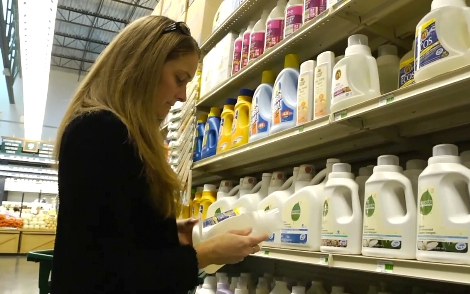Posts Tagged: Alastair Iles
Fishing for aquaculture answers
If you buy fresh fish with any regularity you’ve likely come across tilapia. A relative newcomer to American fish markets, the mild, flakey white fish originated in Africa and was introduced to American markets about 10 years ago, sometimes accompanied by favorable sustainability ratings from markets like Whole Foods. Most farmed tilapia consumed in the U.S. currently comes from fish farms in Central America.
“It's a fast-growing fish species that seems more sustainable because it is usually a plant-eater. That is, the fish can survive on plants rather than other fish,” says Alastair Iles, a UC Berkeley assistant professor of environmental science, policy, and management, whose policy research includes studying aquaculture and in particular farmed tilapia.
But sustainability turns out to be a slippery term. “Producing tilapia brings into play a wide range of issues — how developing countries are trying to create sustainable tilapia farming systems but are also struggling with the pollution and waste that they produce,” Iles says.
The scale of the aquaculture industry is expanding around the world, generating, Iles says, a number of environmental and social impacts that cause increasing concern. In addition to the waste problem that fish farms create, feed made from other fish can deplete fisheries even more, and making soy feed may involve land-based agriculture, which could lead to deforestation in countries like Brazil. Escapes of farmed fishes into the wild harm the genetic diversity of the wild tilapia, and there are land use effects as well. As a result, multiple certification schemes are emerging to try to define "sustainable" aquaculture at the global scale.
“It's essential to look at how these schemes are developing because they may affect what the whole industry looks like in the future,” he says.
Iles and his collaborator Elizabeth Havice, an ESPM Ph.D. graduate who is now an assistant professor at the University of North Carolina, are examining two certification schemes that are currently developing: the Global Aquaculture Alliance, the aquaculture industry trade group; and the World Wildlife Fund, working in partnership with the newly formed Aquaculture Stewardship Council.
A new study by the Sustainable Fisheries Partnership, a non-governmental organization, compares the two schemes, and concludes that the WWF certification is tougher in its requirements than the GAA’s standard in that farmers tend to fail the WWF requirements more often. But there is little insight into why and how these differences occur. Is it because the two organizations are using science in different ways — for example, depending on a relatively narrow fish farm-centered impacts analysis, versus using a life-cycle approach that looks at where all the inputs comes from? Or is it because the negotiators of the schemes are aiming at technology-based standards that only large-scale farms can meet?
Iles and Havice focused on the WWF and GGA schemes as most important, examining how they have been developing their standards, which have different requirements. Like the Sustainable Fisheries Partnership study, the researchers are finding that the WWF standard is more likely to be sustainable than the GAA one.
“We think the World Wildlife Fund has paid much more attention to a participatory process and has heard from many more stakeholders, whereas the GAA has been quite top-down,” Iles says. They plan to publish their findings next year.
For now, what’s an environmentally sensitive consumer to do? Avoid farmed fish like tilapia? Iles says that’s not the answer. “We need aquaculture for the foreseeable future because wild-caught fisheries just can't supply enough fish,” he says.
But he stresses that there are very different ways to practice this aquaculture. The new standards, together with Iles’ research to clarify the science behind them, should help navigate the murky waters.
“Our aim is to help improve the science-based process for developing these standards so that aquaculture can evolve into the most genuinely sustainable forms and will actually change how farmers across the world practice their work,” he says.
In the meantime, Iles recommends that if you are buying farmed fish, ask for certification to help ensure that the fish is more sustainable. The new certifications are just beginning to show up in stores, so, watch for them, and demand from your store that they be used.
Better living through green chemistry
We’ve all noticed the changed landscape on the grocery shelves: eco-friendly brands like Mrs. Meyers, Seventh Generation and even Clorox’s Sierra Club-endorsed Green Works sit next to conventional stalwarts like Tide, Cheer and those ferocious scrubbing bubbles. The new products are the consumers'-eye-view into a quiet “green chemistry” revolution taking shape in university and commercial labs across the country, and in education and public policy.
Even if the proliferation of green cleaning products, office supplies, packaging and appliances make the planet and its inhabitants healthier, the fact remains that more than 80,000 chemicals with uncertain health and environmental impacts currently are registered with the Environmental Protection Agency, with more discovered every day.
“Green chemistry involves discovering and implementing chemical processes and products that are safer, cleaner and more efficient,” said John Arnold, professor of chemistry at the University of California, Berkeley, and director of the campus’s Berkeley Center for Green Chemistry (BCGC).
Last month, the center hosted the sold-out event Green Chemistry: Collaborative Approaches and New Solutions,” the first national conference to take a multidisciplinary approach to this developing area of study. Speakers and panelists came from the EPA, California state government, private industry, departments across the Berkeley campus, and universities across the country, including the 2005 Nobel laureate Robert Grubbs of Cal Tech.
“The Berkeley Center for Green Chemistry has created a multidisciplinary team that represents all aspects of chemistry, from research and development to consumers and the environment,” Arnold said. “Through research, education and engagement, we aim to facilitate change by embedding the principles of green chemistry into science, markets and public policy.”
The BCGC already has begun redesigning undergraduate and graduate student education to include green chemistry by creating greener laboratory experiments and launching an interdisciplinary graduate course in green chemistry funded by California Environmental Protection Agency. But the center aims for a broader impact – on public policy as well as on the chemical industry. “We’re trying to promote activities that address more than one aspect of green chemistry, that also look at economics, business, law, toxicology or public health,” Arnold said.
Green chemistry programs are not new at universities or in the research labs of chemical companies, but most focus only on innovations in chemistry, such as developing catalysts or safer solvents, according to Alastair Iles, a UC Berkeley assistant professor of environmental science, policy and management and a center member. Iles said that these technical developments are critical to achieving sustainability, but they won’t be as effective or be widely used without also finding societal innovations in policy, law, environmental health and business.
“In contrast, BCGC has a vision of integrating multiple disciplinary fields with chemistry so that chemists can work with toxicologists, business experts, regulators and economic experts to develop technologies and products that are non-toxic and sustaining,” Iles said.
Center executive director Marty Mulvihill said that green chemistry is already being taken up by industry because it’s cheaper, it doesn't produce as much waste, it uses less energy, and it creates products that are safer, without the worry over what's going to happen at the end of a product's life.
“It just needs to be taken up by the entire industry in a transparent way that gives businesses and consumers the information they need to make choices,” said Mulvihill.
A key 2008 study led by UC Berkeley environmental health scientists and their UCLA colleagues, formed the technical basis for the state’s Green Chemistry Initiative and new legislation authored by Senator Joe Simitian (D-Palo Alto) and Assemblymember Mike Feuer (D-Los Angeles). Those new laws, and their implementing regulations, could improve public access to information on the sale of chemical products in the state and reductions in some uses of the most toxic chemicals, according to Michael Wilson, BCGC associate director for integrative sciences and an environmental health scientist at UC Berkeley's Center for Occupational and Environmental Health.
As members of the state’s Green Ribbon Science Panel, Wilson and his co-author Megan Schwarzman, the center’s associate director of health and environment, have worked with the DTSC to shape the Green Chemistry Initiative, with the hope that it will improve transparency and accountability in the chemicals market.
“Ultimately, in society, what we would like to see is the design of chemicals and products that don’t come at the expense of humans or the environment,” said Schwarzman. “That would mean creating chemicals that are short-lived and degrade in the environment so they don’t show up in breast milk 30 years after they have been banned, and industrial processes that use benign substances. I think we have the ingenuity and the know-how to do that, and we have to prioritize it as a society.”



